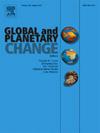Impact of 21st century climate change on Mississippi River Basin discharge in CESM2 large ensemble projections
IF 4
1区 地球科学
Q1 GEOGRAPHY, PHYSICAL
引用次数: 0
Abstract
The Mississippi River Basin (MRB), the fourth-largest river basin in the world, is an important corridor for hydroelectric power generation, agricultural and industrial production, riverine transportation, and ecosystem goods and services. Historically, flooding of the Mississippi River has resulted in significant economic losses. In a future with an intensified global hydrological cycle, the altered discharge of the river may jeopardize communities and infrastructure situated in the floodplain. This study utilizes output from the Community Earth System Model version 2 (CESM2) large ensemble simulations spanning 1930 to 2100 to quantify changes in future MRB discharge under a high greenhouse gas emissions scenario (SSP3–7.0). The simulations show that increasing precipitation trends exceed and dominate increased evapotranspiration (ET), driving an overall increase in total discharge in the Ohio and Lower Mississippi River basins. On a seasonal scale, reduced spring snowmelt is projected in the Ohio and Missouri River basins, leading to reduced spring runoff in those regions. However, decreased snowmelt and spring runoff is overshadowed by a larger increase in projected precipitation minus ET over the entire basin and leads to an increase in mean river discharge. This increase in discharge is linked to a relatively small increase in the magnitude of extreme floods (2 % and 3 % for 100-year and 1000-year floods, respectively) by the late 21st century relative to the late 20th century. Our analyses imply that under SSP3–7.0 forcing, the Mississippi River and Tributaries (MR&T) project design flood would not be exceeded at the 100-year return period. Our results harbor implications for water resources management including increased vulnerability of the Mississippi River given projected changes in climate.
求助全文
约1分钟内获得全文
求助全文
来源期刊

Global and Planetary Change
地学天文-地球科学综合
CiteScore
7.40
自引率
10.30%
发文量
226
审稿时长
63 days
期刊介绍:
The objective of the journal Global and Planetary Change is to provide a multi-disciplinary overview of the processes taking place in the Earth System and involved in planetary change over time. The journal focuses on records of the past and current state of the earth system, and future scenarios , and their link to global environmental change. Regional or process-oriented studies are welcome if they discuss global implications. Topics include, but are not limited to, changes in the dynamics and composition of the atmosphere, oceans and cryosphere, as well as climate change, sea level variation, observations/modelling of Earth processes from deep to (near-)surface and their coupling, global ecology, biogeography and the resilience/thresholds in ecosystems.
Key criteria for the consideration of manuscripts are (a) the relevance for the global scientific community and/or (b) the wider implications for global scale problems, preferably combined with (c) having a significance beyond a single discipline. A clear focus on key processes associated with planetary scale change is strongly encouraged.
Manuscripts can be submitted as either research contributions or as a review article. Every effort should be made towards the presentation of research outcomes in an understandable way for a broad readership.
 求助内容:
求助内容: 应助结果提醒方式:
应助结果提醒方式:


